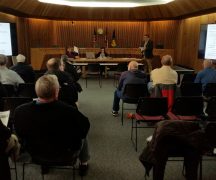By JAN McLAUGHLIN
BG Independent News
Affordable housing remains elusive to many potential homeowners in Wood County – especially for certain pockets of population.
Some of the roadblocks are the same as were identified during the last fair and affordable housing study conducted in the county five years ago. Those repeats include the lack of public transportation, and lack of affordable housing especially for people with disabilities and low incomes.
The study, contracted for by the Wood County Planning Commission, showed that many local homeowners have mortgage payments above the recommended amount. The traditional rule of thumb is that no more than 28% of a homeowner’s monthly gross income should go to their mortgage payment.
In Wood County, approximately 16% of homeowners are paying a monthly mortgage of more than 30% of their household income.
The report states that the median value of owner-occupied houses in the county is $203,300, with a median mortgage of $1,552. It also notes that 36% of residential renters spend more than 30% of their household income on monthly rent.
To put that into numbers – Wood County has 3,511 owner households and 6,978 renter households that are cost burdened by mortgages or rent.
“Though the economy is strong, inflation has hit some families harder than others,” the study stated.
Dave Steiner, the director of the Wood County Planning Commission, can attest to the need for more affordable housing options in the county. It took 1½ years for his family – with incomes of two professionals – to find a home in Bowling Green.
“The lack of housing stock in Bowling Green has been talked about for years,” he said.
Though long identified as a problem, interest rates and economic factors have not improved the issue, he said.
“If anything it’s gotten worse,” Steiner said. “Housing all over is pretty high.”
While housing in the rural areas of the county tends to be less expensive, most of the smaller towns lack new construction and all lack public transportation.
The Great Lakes Community Action Partnership has been searching for solutions to transportation issues, Steiner said.
“They have been working on it – but it’s difficult,” with such a geographically large county, he said.
The fair housing report points out steps that could alleviate some of the impediments to affordable housing, such as:
More fair housing education and outreach with a goal of creating a better understanding of fair housing laws by the public, including landlords, real estate agents, brokers and others.
The report identified some issues with landlords failing to make reasonable accommodations for people with disabilities and with service animals.
“We need to educate landlords that you have to make those accommodations,” Steiner said.
Increase public transportation opportunities in Wood County, especially for senior citizens, people with disabilities and with low incomes.
The lack of comprehensive transit services for Wood County was seen as an impediment and a major obstacle to housing choice, especially for low‐income families and individuals, as well as people with disabilities. The report stated a total of 15,578 people with disabilities in Wood County.
The Wood County Coordinated Public and Human Services Transportation Plan 2018‐2022 found that there are unmet mobility needs for employment, childcare, grocery shopping, and pharmacy in outlying areas. Additionally, there is no public transportation late at night, on Sundays, or holidays in other areas. The absence of reliable public transportation throughout the county limits housing choices for the disabled and low‐income populations.
The county will look at exploring expansion of the existing transportation services in conjunction with the Wood County Housing and Homelessness Coalition, United Way, Great Lakes Community Action Partnership, the Wood County Committee on Aging, and Job and Family Services. The county may also explore the feasibility and costs associated with coordination of transit services offered by other public transportation authorities in surrounding areas.
With a growing elderly and disabled population, such services will be more in demand in the future.
Prevent foreclosures and evictions by increasing consumer knowledge on topics such as credit counseling and money management.
The housing study tracked property foreclosure filings over that past five years. The highest number of 336 was seen in 2019, followed by dips to 178 in both 2020 and 2021 during the COVID pandemic when protections from foreclosures were enacted. The number crept up to 250 in 2022, and dropped a bit to 223 in 2023.
Focus on those with greatest needs. There is a lack of affordable and accessible housing for people with disabilities and mobility issues. This is a growing need given the aging population and their desire to remain in their place of residence for as long as possible. Wood County has 14,902 households with an individual 65 and older. Additionally, there are 6,035 people with disabilities who are over 65 years of age.
Many elderly and disabled households are severely cost burdened, meaning that they are paying 50% or more of their monthly income for housing expenses. Housing and credit counseling along with money management workshops are needed, but often, these programs are not adequately funded and are offered at inconvenient times.
The report also recommended the following:
- Promote increasing the supply of affordable housing in the county through economic incentives and assistance of Community Development Block Grants.
- Strengthen tenant-landlord counseling, by providing educational material and agency referrals for tenant-landlord issues. Wood County’s housing stock is 64% owner‐occupied and 35% renter occupied reflecting BGSU’s student enrollment.
- Reinforcement the local commitment to fair housing by the Wood County Commissioners enacting a fair housing resolution.
- Wood County will continue to use its CDBG and CHIP funds to assist its disabled/mobility impaired households. CHIP assistance to existing homeowners should help such households remain in their homes by providing necessary rehabilitation/repairs.
- As part of its ongoing fair housing outreach activities, the county will continue to raise public awareness of predatory lending, onerous background checks and issues with rental units, and lead‐based paint. Predatory lending awareness is still necessary, and education should be available for homebuyers. Education could also help to keep foreclosure rates down.
- More enhanced tenant‐landlord counseling and mediation is needed. Most of Wood County’s fair housing calls involve tenant landlord issues. Two issues associated with tenant‐landlord counseling are “onerous” background checks and rental units with lead‐based paint. According to the study, some apartment leasing offices are turning away prospective renters based on information from background checks that may be old and involve minor legal infractions. Other landlords are reluctant to rent to households with children in the event that their units may have lead‐based paint.



